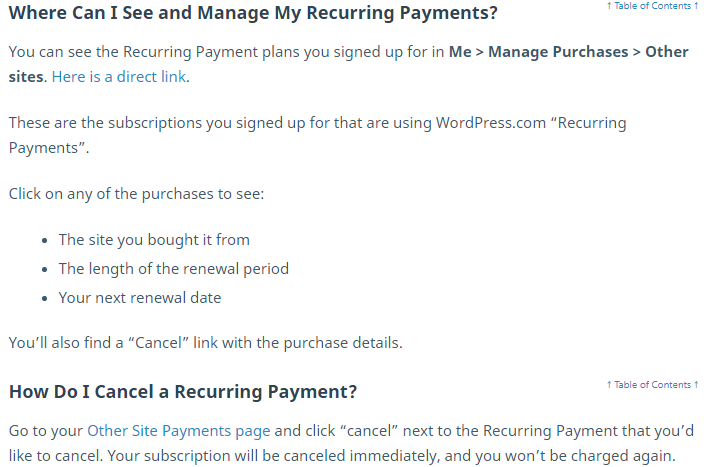“Start a WordPress blog this year” was perhaps one of your new year resolutions. It’s November though, and your dream blog is well, still a dream. If this is you, fret not, you’re not alone. Reports say 60 percent of us make new year resolutions, but only 8 percent achieve theirs.
But there’s good news. With a few weeks to year-end, you can still do something about your dream blog, even if you choose to start your WordPress blog in the new year. Thanks to Recurring Payments, intending bloggers now have another cool reason to start a WordPress blog this year.
With Recurring Payments, site owners can sell subscriptions to visitors directly from their WordPress site. It enables site owners to sell access to products, services, subscriptions, site memberships, etc.
Users can also receive contributions and donations using Recurring Payments. This feature makes it easier for site owners to generate revenue for their sites or blogs.
Other WordPress Billing Plugins You May Know
WordPress features some other interesting billing plugins to help site owners receive payments. These are mostly third-party plugins, designed to work on WP sites. Some of them integrate with popular payment gateways like PayPal, Stripe, Authorize.NET, among others.
They include:
- YITH Woocommerce Subscription
- Moonclerk WP Shortcode
- WP Payment
- QualPay Payment Plugin for WooCommerce
- PayPal Recurring Payment
They also allow you to receive one-off payments and may require you to use codes.
So,
Why Is Recurring Payments Important?
One of the leading concerns for intending bloggers is how to generate endless blog post ideas. Another major concern, in fact, one of the most popular is how to monetize a blog. This is understandable considering the increasing number of people making a full-time living from blogging.
With Recurring Payments (RP), bloggers/webmasters can now fix this and earn more from their sites.
Other Ways People Earn Money From Their blogs
These include:
- Affiliate Marketing
- Advertisement (PPP, PPC, CPM, Text Link, In-Text, Widgets, Ad Space, RSS Ads, etc)
- Product Reviews
- Selling products/services
- Ebooks
- Guides
- Tutorials
- Courses
- Webinars
- Consultancy
- Sponsorships
- Memberships
- Donations, etc
Some of these can be facilitated with RP. As its name implies, Recurring Payments helps you collect recurring payments on your WordPress Site, and it is a native WP feature. This will ensure seamless integration and constant updates.
Here’s
How WordPress Recurring Payments Works
When visitors or subscribers pay for products or services using Recurring Payment, they are charged the same amount, same time, every month or year, depending on the subscription or renewal period. It’s like automatic billing so they won’t have to miss a subscription or payment.
This ensures steady uninterrupted service for customers, as well as steady revenue for site owners; a win-win.
Renewal period and subscription amount may vary from site to site and require a WordPress.Com site to function. During setup, subscribers can see how much and for how long their subscriptions will run, before committing.
Subscribers can also cancel their subscription anytime and won’t be billed again.
Transactions are between buyers and sellers, platform and processes are managed by WordPress (WP doesn’t store buyers credit card information) with Stripe as payment processor.
The image below shows
How to Manage or Cancel Recurring Payments
The user dashboard allows subscribers to manage their subscriptions and recurrent payments. Subscribers can also cancel their recurring payments anytime.

Source: WordPress
Different Plans and Pricing
There are different plans and pricing for WordPress Recurring Payments.
Free: The Free Plan is great for students and those just starting out with WordPress.
Personal: The Personal Plan is best suited for personal use and starts at $4 a month billed
yearly.
Premium: The Premium Plan starts at $8 a month billed yearly, and is designed for
freelancers.
Business: The Business Plan is best for small businesses and starts at $45 a month.
Ecommerce: Ecommerce stores will love the eCommerce Plan, and it begins at $45 a month.

Source: WordPress
There are so many benefits of blogging, and blogging regularly. As part of a bigger content marketing strategy, blogging helps you reach new customers, establish authority and drive much-needed organic traffic for your business.
With Recurring Payments brands have one more reason to start blogging as soon as possible.
Conclusion
Recurring Payments is easy to set up, safe, secure and a new and convenient way to monetize your WordPress site.
Author Bio
Amos Onwukwe is an AWAI trained Business and Ecommerce Copywriter who also covers Tech and Social Media. When not writing, he’s thinking of writing or making music. He’s been featured in Huffington Post, Dumb Little Man, Ecommerce Nation, eCommerce Insights, Understanding Ecommerce, Result First, Floship, GrowMap, Self Growth, among others.
You can connect with him on
Twitter: @amos_onwukwe
LinkedIn: Amos Onwukwe
Related Posts












